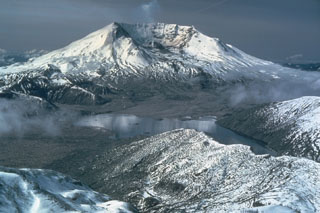Report on St. Helens (United States) — June 1998
Bulletin of the Global Volcanism Network, vol. 23, no. 6 (June 1998)
Managing Editor: Richard Wunderman.
St. Helens (United States) Seismicity increases further; magmatic CO2 detected
Please cite this report as:
Global Volcanism Program, 1998. Report on St. Helens (United States) (Wunderman, R., ed.). Bulletin of the Global Volcanism Network, 23:6. Smithsonian Institution. https://doi.org/10.5479/si.GVP.BGVN199806-321050
St. Helens
United States
46.2°N, 122.18°W; summit elev. 2549 m
All times are local (unless otherwise noted)
The number of well-located earthquakes at Mount St. Helens had increased from an average of ~60 per month last winter, to 165 in May, to 318 in June. However, the June earthquakes were very small: only 11 events were larger than M 1 and the largest was M 1.8. Hence, the total seismic-energy release for June was about the same as that of May. Earthquakes continued to occur chiefly in two depth clusters directly beneath the lava dome in the crater. One cluster was 2-5 km below the dome, the other in the depth range of 7-9 km. Almost no events were located in the very shallow region (0-2 km below the dome). The Cascades Volcano Observatory began providing daily updates showing plots of the number of events and amount of seismic energy registered. The plots are available through the observatory web site.
In response to the increased seismicity, USGS scientists also increased broad-based monitoring in June. An airborne gas survey revealed the presence of magmatic CO2. Because it is heavier than air, CO2 can concentrate in surface depressions in the dome or crater floor, especially under calm conditions, and can pose an asphyxiation hazard. Poorly ventilated cavities, such as caves in the mass of snow and ice that is accumulating behind the dome, could also be hazardous.
A network of surveying targets was established on the lava dome, crater floor, and lower flanks of the volcano to detect any ground movements that might occur in response to changes beneath the volcano. No significant movement occurred at any of the targets on the N flank of the dome between the first measurements on 5 June and a follow-up survey on 29 June. Additional measurements of survey targets will be repeated periodically for the foreseeable future.
The increased number of earthquakes and the release of CO2 probably reflect replenishment of the magma reservoir, a body whose top is thought to lie ~7 km below the crater. Replenishment could lead to magmatic eruptions but scientists don't know how much replenishment has occurred, or how much is necessary to renew magmatic eruptions. However, such eruptions are unlikely without a significant increase in precursory activity. Owing to the recent unrest, the probability of small steam explosions from the dome, like those that occurred between 1989 and 1991, has increased slightly. Concern will be heightened greatly if shallow seismicity increases.
Geological Summary. Prior to 1980, Mount St. Helens was a conical volcano sometimes known as the Fujisan of America. During the 1980 eruption the upper 400 m of the summit was removed by slope failure, leaving a 2 x 3.5 km breached crater now partially filled by a lava dome. There have been nine major eruptive periods beginning about 40-50,000 years ago, and it has been the most active volcano in the Cascade Range during the Holocene. Prior to 2,200 years ago, tephra, lava domes, and pyroclastic flows were erupted, forming the older edifice, but few lava flows extended beyond the base of the volcano. The modern edifice consists of basaltic as well as andesitic and dacitic products from summit and flank vents. Eruptions in the 19th century originated from the Goat Rocks area on the N flank, and were witnessed by early settlers.
Information Contacts: William E. Scott, Cascades Volcano Observatory, U.S. Geological Survey, 5400 MacArthur Blvd., Vancouver, WA 98661, USA (URL: https://volcanoes.usgs.gov/observatories/cvo/).

